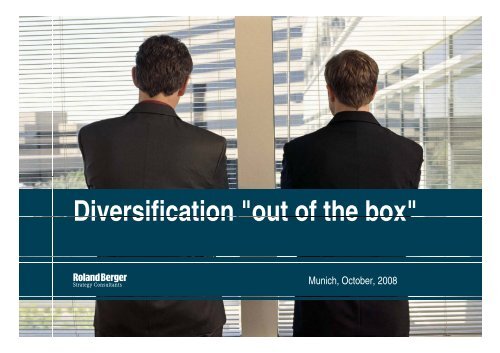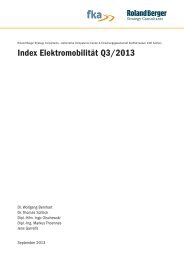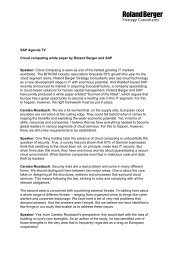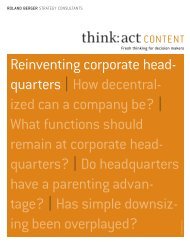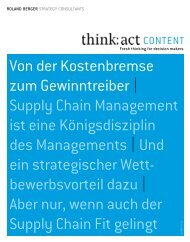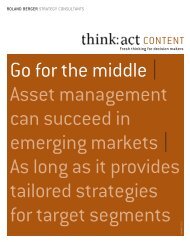Diversification "out of the box" - Roland Berger
Diversification "out of the box" - Roland Berger
Diversification "out of the box" - Roland Berger
- No tags were found...
Create successful ePaper yourself
Turn your PDF publications into a flip-book with our unique Google optimized e-Paper software.
<strong>Diversification</strong> "<strong>out</strong> <strong>of</strong> <strong>the</strong> box"Munich, October, 2008
ContentsPageA. Our approach – A structured concept based on four building blocks 4B. Portfolio transparency – Bringing existing businesses to target performance 6C. Portfolio management – Reshaping <strong>the</strong> portfolio (invest, divest) 18D. Role <strong>of</strong> <strong>the</strong> center – Matching organization and processes with portfolio logic 36E. <strong>Roland</strong> <strong>Berger</strong> – Our experience 49© 2008 <strong>Roland</strong> <strong>Berger</strong> Strategy Consultants GmbH 2
A. OUR APPROACH –A structured concept based on four building blocks<strong>Roland</strong>_<strong>Berger</strong>_<strong>Diversification</strong>_<strong>out</strong>_<strong>of</strong>_box_20090907.PPTX3
Some few care questions regarding diversification can beobservedDIVERSIFIED COMPANIESFOCUSED COMPANIES> Where to optimally invest – allocatingmoney to existing i or entering newbusinesses?> Which businesses should potentially bedivested?d?> What is <strong>the</strong> right "role <strong>of</strong> <strong>the</strong> center" andhow to avoid a "conglomerate discount"??> What could be adjacent growth options,streng<strong>the</strong>ning <strong>the</strong> current business?> What are strategic options if fur<strong>the</strong>rgrowth in core business or adjacentbusinesses is limited or even at risk?4
Our modular approach consists <strong>of</strong> four building blocks –applicable for both diversified and still focused companies1Portfolio transparency 3 Role <strong>of</strong> <strong>the</strong> center 4 Implementation> Conduct bottom-up portfoliosegmentation> Achieve portfolio transparency> Definecore businesses> Review portfolio elements "target performance"and derive initiatives(pr<strong>of</strong>itability/growth measures)2 Portfolio management> Derive portfolio logic> Conduct valuation and identifydivestment candidates> Search for growth options (organic,inorganic)> Get agreement from share- andstakeholders> Review <strong>of</strong> "role <strong>of</strong> <strong>the</strong>center" (incl. costbenchmarks vs. o<strong>the</strong>rholdings)> Development <strong>of</strong>cornerstones for futuregroup organization> Blueprint and roughdimensioning <strong>of</strong> holdingfunctions (andmanagement processes)> Set-up <strong>of</strong> implementationplan– Responsibilities– Tasks, Milestones, andTimelines> Develop communicationconcept (internal, capitalmarkets)> Prepare <strong>of</strong> board meetingfor decisioniSource: <strong>Roland</strong> <strong>Berger</strong>5
B. PORTFOLIO TRANSPARENCY –Bringing i existing businesses to target t performance<strong>Roland</strong>_<strong>Berger</strong>_<strong>Diversification</strong>_<strong>out</strong>_<strong>of</strong>_box_20090907.PPTX6
Our modular approach consists <strong>of</strong> four building blocks:Portfolio transparency1 Portfolio transparency 3 Role <strong>of</strong> <strong>the</strong> center 4 Implementation1.11.21.31.4Conduct bottom-up portfoliosegmentationAchieve portfolio transparencyDefine core businessesReview portfolio elements "targetperformance" and derive initiatives(pr<strong>of</strong>itability/growth measures)2 Portfolio management> Derive portfolio logic> Conduct valuation and identifydivestment candidates> Search for growth options (organic,inorganic)> Get agreement from share- andstakeholders> Review <strong>of</strong> "role <strong>of</strong> <strong>the</strong>center" (incl. costbenchmarks vs. o<strong>the</strong>rholdings)> Development <strong>of</strong>cornerstones for futuregroup organization> Blueprint and roughdimensioning <strong>of</strong> holdingfunctions (andmanagement processes)> Set-up <strong>of</strong> implementationplan– Responsibilities– Tasks, Milestones, andTimelines> Develop communicationconcept (internal, capitalmarkets)> Prepare <strong>of</strong> board meetingfor decisioniSource: <strong>Roland</strong> <strong>Berger</strong>7
In most companies, <strong>the</strong> organization <strong>of</strong> business units doesn'tfollow a "true market logic"Illustrative examplesConstructionCoUtilityCoHighTechCoDoors> Entry doors> Garage doorsGarageDoor openers…PowerPowerPower retailgeneration transmission &distributionTouring qualitymicrophones &speakers…> Are entry andgarage doorsreally onebusiness?> Shouldn'tgarage doorsopenersmanagedtoge<strong>the</strong>r withgarage doors?> Is transmission & distribution anown business?> What is <strong>the</strong> right regional marketdefinition for generation? (does itmake sense to expandgeographically?)> Is it possible tosell electricitywith<strong>out</strong> owngenerationcapacities?> Are speakers µphonesreally onbusiness, onlybecause <strong>of</strong>similardistributionchannels? ca esA bottom-up portfolio segmentation is needed to understand businesscompetitive position and to derive right strategic insights8
1.1A proper bottom-up portfolio segmentation is <strong>the</strong> first step toachieve portfolio transparencyHighCostSharingLowOne portfolio element(synergies might allowfor <strong>out</strong>pacing strategy)Related, but separate portfolioelements (synergies can lead tocost leadership)LowUnrelated portfolio elementsCustomer SharingOne portfolio elementRelated, butseparateportfolioelements(might bebundled)One portfolioelement(products mightsubstitute eacho<strong>the</strong>r)HighIn additionREGIONALSCOPE OFBUSINESS tobe analyzedPortfolio segmentation should mirror boundaries <strong>of</strong> <strong>the</strong>battlefield within which companies compete at <strong>the</strong> market9
1.1 EXAMPLESThe correct portfolio segmentation can lead to insights, whilstincorrect segmentation can result in serious consequencesINSIGHTS FROMCORRECT PORTFOLIO SEGMENTATIONSTRATEGIC> Should we buy or sell <strong>the</strong> attractive business?> Should we expand into new geographies?> Are we vulnerable to low cost countries?> Should we vertically integrate into growingdownstream/upstream?> Can we exit a business with<strong>out</strong> weakening <strong>the</strong> corebusiness?> Do we have to grow through M&A to be successful in<strong>the</strong> future?OPERATIONAL> Should we drop this product line?> Should we merge our salesforce?> How should we plan our manufacturing footprint?> Should we centralize our activities to achieve higherscale? (e.g. distribution centers; salesforce)STRATEGIC CONSEQUENCES OFINCORRECT PORTFOLIO SEGMENTATIONCUSTOMERS> Neglect pr<strong>of</strong>itable customer segments or over-investin unpr<strong>of</strong>itable customers> Give away opportunities to capture synergies> Misjudge relevant trends> Overlook relevant geographiesCOSTS> Induce unnecessary costs> Give away opportunities to capture synergies> Do not transfer experience> Under invest in important R&D initiativesCOMPETITORS> Overlook threats from competition> Miscalculate "real market share" (as proxy for scale andachievable pr<strong>of</strong>its)> Set inappropriate targets> Overlook relevant capacity changes in <strong>the</strong> industry> Misjudge true cost position10
1.1BACKUPWrong business definition can result in major strategic failuresCOMPANYCORE DEFINITION MISTAKEOUTCOMETOO NA ARROWTOO BROAD> Polaroid defined it's core aschemical/paper based processing andmissed <strong>the</strong> broader definition <strong>of</strong> imagecapture in <strong>the</strong> digital age> American Express believed charge cardsand credit cards were separatebusinesses. Charge card division lostmoney due to poor cost position and failedmarketing strategyt> Gillette viewed its core as "check<strong>out</strong>purchases" and thus diversified intobatteries (Duracell) and writing instrumentst(Parker)> Saatchi viewed advertising and consultingas one business; failed to transferexpertise and suffered from lack <strong>of</strong> focus> Went Bankrupt in 2001> 50% drop in market value(1986-1991)> Stock price reduced by greater than 50%(1998-2001)> Company suffered severe losses due toinability to transfer experience, lack <strong>of</strong>focus, and tainted imageSource: <strong>Roland</strong> <strong>Berger</strong>11
1.2 EXAMPLEThe analysis <strong>of</strong> properly segmented portfolios can be based on"market attractiveness" and "competitive position"Project exampleSTRATEGIC IMPERATIVESMarketattractiveness> Market size> Market growth> Marketpr<strong>of</strong>itability54321DalcombankTS-RetailBinn<strong>of</strong>armMBRDSitronicsSistema-HalsMedsi/Medsi-2MTTMTSDetskiy Mir/DM CenterSky LinkRussian World StudiosIntouristConcern RTI SystemsSistema mass-mediaComstar OTC/MGTS> Top position: Fur<strong>the</strong>rinvest in businesses (andgrow in related areas)> Borderliner: Bring tostrategic and/or operational"target performance" andmove to top pp position (e.g.increase market share tosustainable size by M&A,restructure operations)00 1 2 3 4 5> Weak position: Divest (orperform "leap frog")Top positionBorderlinerWeak position> Relative market shareCompetitive position> Relative performance (e.g. ROCE/ROS vs. competitors)> Performance vs. key purchasing factorsSource: <strong>Roland</strong> <strong>Berger</strong> Project example12
1.3 EXAMPLEThe definition <strong>of</strong> core business and "satellites" should bebased on a sharing analysis (and size/ financial performance)Project example (Related <strong>Diversification</strong>)RELATEDNESS ANALYSISCORE DEFINITIONCapability sharingCost sharingCustomer sharingABCDA B CA 100% 8% 5%BA 8% B 100% C 13%DA C100% 5% 8% 13% 5% 100% 10%B A D 8% B 10% 100% C 60% 13% D 80% 50%C100% 5% 8% 13% 5% 100% 10% 80%D8% 10% 100% 60% 13% 80% 50%100%5% 13% 100% 80%10% 60% 80% 100%D10%50%80%100%"UnrelatedBusinesses"PackagingProcessingConsumerBusinessProjectBusinessPro-fessionalRelatedBusinessesCoreBusinesses> Assessment <strong>of</strong> relatedness <strong>of</strong> businessesby using three main criteria (andrespective sub-criteria)> Calculation <strong>of</strong> "economic relatedness" asweighted average <strong>of</strong> criteriaMROAutomotiveElectronicsDetailed input for concrete synergies measuresPortfolio logic with indication for "role <strong>of</strong> <strong>the</strong> center"Source: Project example13
1.4ILLUSTRATIVEBefore deciding on portfolio changes, <strong>the</strong> future "targetperformance" has to be evaluatedPoint <strong>of</strong> DepartureTarget performanceMarketMarketattractivenessattractiveness5 544332211 2 3 4 5211 2 3 4 5Competitive positionCompetitive positionCore revenuesNon-core revenuesSource: <strong>Roland</strong> <strong>Berger</strong>14
1.4ILLUSTRATIVEPortfolio options should be based on "target performance"assessmentProject exampleIllustrativetarget performance PortfolioOptions"Optimize Status Quo""Focus on regionalexpansion""Focus on winningbusinesses""O<strong>the</strong>r strategicoptions"High-level analysis <strong>of</strong> keyimplicationsStrategic> Portfolio implications> Market position?Financially> Revenues> EBIT> Investment needsInvestors' storyline> Shareholders> Analysts, Press, etc.Likelihood <strong>of</strong> option success> What do we have to believe for each option?> How likely is that?> Discontinuities to influence?Source: <strong>Roland</strong> <strong>Berger</strong>15
1.4To capture <strong>the</strong> "target performance" per business, four majorbuilding blocks have to be analyzedValue driversStrategicOperationalOrganizationalFinancial> Do we have <strong>the</strong> rightscale? How do we> Are we maximisingour revenues? e.g.build it?– Customer> Who is <strong>the</strong> bestsegmentation‘parent’ for activities – Product designwe undertake? – Deliveryexcellence> Are we minimisingour costs?> Are we measuringourselves effectively?> Do we have <strong>the</strong> rightcapabilities?> Is it clear who makesdecisions?> Do we have a highperformanceculture?> Are we valued andpriced appropriately?> Can we increaseworking capital andcash flow?> Is <strong>the</strong> balance sheetoptimized?> How efficient is ouruse <strong>of</strong> capital?Source: <strong>Roland</strong> <strong>Berger</strong>16
1.4ILLUSTRATIVETop-down targets for strategic and operational "targetperformance" can be derived from ROS/RMS analysisROS/RMS – IllustrativeReturns earned (ROS)HighLowCost <strong>of</strong> capitalSubscale(below strategictargetperformance)Restructuring case(below target performance)ClientCo businesseswith sustainablerelative market share(local, regional)?ClientCo businessesat operational targetperformance?LowRelative market share (RMS)HighSource: <strong>Roland</strong> <strong>Berger</strong>17
C. PORTFOLIO MANAGEMENT – Reshaping <strong>the</strong> portfolio<strong>Roland</strong>_<strong>Berger</strong>_<strong>Diversification</strong>_<strong>out</strong>_<strong>of</strong>_box_20090907.PPTX18
Our modular approach consists <strong>of</strong> four building blocks:Portfolio management1Portfolio transparency> Conduct bottom-up portfoliosegmentation> Achieve portfolio transparency> Definecore businesses> Review portfolio elements "target performance"and derive initiatives(pr<strong>of</strong>itability/growth measures)2 Portfolio management2.1 Derive portfolio logic2.2Conduct valuation and identifydivestment candidates2.3 Search for growth options (organic,inorganic)> Get agreement from share- andstakeholders3 Role <strong>of</strong> <strong>the</strong> center 4 Implementation> Review <strong>of</strong> "role <strong>of</strong> <strong>the</strong>center" (incl. costbenchmarks vs. o<strong>the</strong>rholdings)> Development <strong>of</strong>cornerstones for futuregroup organization> Blueprint and roughdimensioning <strong>of</strong> holdingfunctions (andmanagement processes)> Set-up <strong>of</strong> implementationplan– Responsibilities– Tasks, Milestones, andTimelines> Develop communicationconcept (internal, capitalmarkets)> Prepare <strong>of</strong> board meetingfor decisioniSource: <strong>Roland</strong> <strong>Berger</strong>19
2.1EXAMPLEThe overall portfolio logic is <strong>the</strong> most crucial question forClientCo managementPORTFOLIO LOGICQuestion for ClientCo (<strong>out</strong>side-in)RiskSynergyFocused vs. diversifiedRelated vs. Unrelated businesses 1)> How to reduce dependency onXY businesses? (if needed)Vl Value chain hi Production vs. services> How to position ClientCo("related diversifier" vs.Products Commodity vs. niche/specialists"conglomerate") ?LifecycleRegionsO<strong>the</strong>rMature vs. emerging industriesiRussia vs. emerging countries vs. world> How does <strong>the</strong> technologybusiness unit fit in <strong>the</strong> portfolio(production vs. services)?Potential for <strong>the</strong> holding to contribute value1) Related business to achieve synergies between portfolio elements due to high customer, cost, capability sharingSource: <strong>Roland</strong> <strong>Berger</strong>20
2.1BACKUPThe portfolio logic need to be evaluated on a detailed basis toavoid value destructionVivendi – The synergy dream"(We will be) <strong>the</strong> world's preferred creator and provider <strong>of</strong>personalized information, entertainment and services to consumersanywhere, at any time and across all distribution platforms andservices."Jean-Marie Messier, <strong>the</strong>n CEO, Vivendi Universal, April 2001"You need to look at (Vivendi Universal) as <strong>the</strong> General Electric <strong>of</strong>entertainment – <strong>the</strong>n it is a beautiful company. If, on top <strong>of</strong> that,you create <strong>the</strong> convergence, <strong>the</strong>n it is even more beautiful. Buteven if we fail, you still have GE."Dennis Olivennes, Deputy <strong>of</strong> Canal Plus, April 2001Vivendi – Refocusing to Telco & Media"Contrary to what was hoped for and what was proclaimed, Vivendihas no significant synergies between its components. […] IfJean-Marie Messier had remained chief executive, Vivendi Universalwould have declared itself insolvent within 10 days."Jean-Rene Fourtou, CEO, Vivendi Universal, May 2003"… <strong>the</strong>re never was a business model <strong>of</strong> <strong>the</strong> future hidden amongVivendi's disparate holdings. The assets assembled by Mr. Messierwere a grab-bag, nothing more."Manager's Journal, Wall Street Journal, May 2003Share price 31.12.98-31.12.02 vs. index [%] Share price 31.12.02-29.08.08 vs. index [%]VIV: 172SBF: 81 SBF: 151VIV: 21Source: <strong>Roland</strong> <strong>Berger</strong>, Press research, Thompson financial21
2.1PROJECT APPROACHThe definition <strong>of</strong> <strong>the</strong> future portfolio logic should be elaboratedin close collaboration with <strong>the</strong> ClientCo top-managementInteractive development <strong>of</strong> future portfolio logicInput from "as is" analysis> Understanding <strong>of</strong> current businessesperformance and <strong>the</strong>ir "target tperformance" (strategic, operative,financial)> Analysis <strong>of</strong> relatedness (synergies,similarity <strong>of</strong> success factor) betweenbusinesses and "core definition"> Description <strong>of</strong> ClientCo strength andassets– Operations/USP– HoldingCooperation with ClientCo Top-ManagementExpert interviews to challenge results and test/derivehypo<strong>the</strong>sesWorkshop with Top-Management to agree on futureportfolio logicSource: <strong>Roland</strong> <strong>Berger</strong>22
2.2ILLUSTRATIVEThe arithmetic for valuation <strong>of</strong> portfolio elements has to beagreed with ClientCo management at <strong>the</strong> beginning <strong>of</strong> <strong>the</strong> projectBusiness unit pr<strong>of</strong>itability+ EBIT"Pearls"Increased valueROCE > WACC > 0Pr<strong>of</strong>itability <strong>of</strong>capitalROCEDeviation vs.risk adjustedmarketpr<strong>of</strong>itabilitySpreadROCE - WACCCapitalEmployedCE"Underperformers"–Decreased valueROCE < WACC < 0Risk adjustmentTotal cost <strong>of</strong> capitalWACCSource: <strong>Roland</strong> <strong>Berger</strong>23
2.2ILLUSTRATIVEAfter defining <strong>the</strong> portfolio logic, <strong>the</strong> actual businesses have tobe evaluated "strategically"Value based portfolio (status quo)Deviation vs.risk adjustedmarketpr<strong>of</strong>itability+–Hold with<strong>out</strong> fur<strong>the</strong>r investmentsFinance futrher growth(Divest if good deal)DivestLowBubble size = invested capital (assets)BU 7e.g.: Are significant additionalinvestments required to keepgood pr<strong>of</strong>itability?e.g.: Does this business havea sustainable relative marketshare?BU 3 BU 2BU 6e.g.: Who would be abetter corporateparent?BU 1Fit to portfolio logicBU 4e.g.: What are additionaladjacent growthopportunities?Restructure or exitBU 5"Pearls"e.g.: What are (additional)initiatives) to reach operationaltarget performanceHigh"Underperformer"Source: <strong>Roland</strong> <strong>Berger</strong>24
2.2EXAMPLE"Underperformer" businesses have to checked for future"target performance" before final decisionValue based portfolio (underperformer businesses only)HighValue creationopportunities withinbusiness(bring businesses toDRESSING UP &PREPAREFOR SALEMANAGE FORMAXIMUM VALUE(RESTRUCTURE)"target performance") DISINVEST RAPIDLY PREPAREFOR SALELowLowFit to portfolio logicHighSource: <strong>Roland</strong> <strong>Berger</strong>25
2.3Growth options: Different approaches have to be chosendepending on agreed portfolio logicRELATED DIVERSIFICATIONUNRELATED DIVERSIFICATIONNew geographiesNewdistributionchannelsNew products/servicesCurrentcoreNew parts<strong>of</strong> value chainNewbusinessesNewcustomersegmentsFirstSelectionIndustryfunnelSegmentanalysisIdentification <strong>of</strong> potential growth areas> Brainstorming> Idea tree> Horizontal/ verticalintegration> Opportunities in <strong>the</strong>marketPrioritization <strong>of</strong> industries> Coherence withdiversification goals> Pr<strong>of</strong>itability> Synergies (tbd)> "Fit"> "Success stories"> Activities <strong>of</strong> stakeholders> Trend-Analyses> etc> Reasons for exclusion– Moral, Ethics, Politics– Controllability(Technology Mgmt.)– Ownership structure & sizeDefinition for "deep dive" segments> Market attractivenessti > Market barriers> Competitive landscape > Cost <strong>of</strong> market entry> Threats (e.g. substitution) > etcPotential ti targetst26"Starting search from core""Funneling attractive opportunities"Source: <strong>Roland</strong> <strong>Berger</strong>26
2.3RELATED DIVERSIFICATIONIdentifying businesses for successful related diversificationrequires a methodical approachBuild factbase to support decision makingAssess strength<strong>of</strong> coreIdentify full set<strong>of</strong> opportunitiesPrioritizeopportunitiesDevelop entrystrategy> Assess <strong>the</strong> strength > Identify and map <strong>the</strong><strong>of</strong> core business and full set <strong>of</strong> businessesidentify opportunitiesrelated toto reinforce <strong>the</strong> core existing corebusinessbusiness(es)> Determine whichopportunities aremost attractive topursue– Evaluate odds <strong>of</strong>success (relatednessto corebusiness, abilityto differentiate)– Assessattractiveness> Within targetbusinesses,determine bestgrowth <strong>the</strong>mes,potentialacquisition targets,and organicopportunities> Organize forsuccess2727
2.3 RELATED DIVERSIFICATIONThe growth spider can help to identify fur<strong>the</strong>r opportunitiesClient exampleStorageTechnologyInertIngredientsMaterialsRetortablePreserved& StableChilledAsepticTetraPouchTetraManyTetraBrikTetraClassicPackageTypesValuePortionValueFamilyPremiumFamilyCustomerSegmentsPremiumPortionO<strong>the</strong>r LineEquipmentValue ChainPlasticFilmProductContentsPlasticClosuresSBMPreformsPlastic Paper-PackagingBottle BoardCreamSwedenMilkNor<strong>the</strong>rnEuropeValue Added S<strong>out</strong>hernDairyEuropeJuiceO<strong>the</strong>r StillEarly AsiaFood &BeerBeveragesCarbonatedDrinksMilkProcessingLatinAmericaUSACheeseProcessingChinaFactoryManagementGeographySource: <strong>Roland</strong> <strong>Berger</strong>28
2.3RELATED DIVERSIFICATIONOdds <strong>of</strong> success for related diversification decrease withhigher distance to coreSharedcustomersSharedcostsSharedchannelsSharedcompetitorsSharedcapabilities/technologyCoreOdds <strong>of</strong> success1 stepdiversification2 stepdiversification3 stepdiversificationUnrelated"stand alone"PRIMARYDIMENSIONSFull share Partial share No shareSource: <strong>Roland</strong> <strong>Berger</strong>29
2.3RELATED DIVERSIFICATIONDistance to core needs to be defined properlyCRITERIACustomersharingCostsharingCapabilitysharingChannelsharing (tbd)CompetitorsharingDEFINITION> Percentage <strong>of</strong> > Percentage <strong>of</strong> <strong>the</strong> > Extent to which <strong>the</strong> > Percentage <strong>of</strong> > Percentage <strong>of</strong>incrementalrevenue generatedfrom existingcustomer basenew cost base thatlends itself tosharing with <strong>the</strong>existing businesstarget businessutilises existingtechnology andbusiness modelsadditional revenuegenerated throughexisting channelplayersincremental newmarket made up <strong>of</strong>existing competi-tors (excludingshare held byentrant)0-20% 0-5% No technology orbusiness model0-20% 0-20%21-40%5-15%overlap21-40%21-40%41-60%16-25%41-60%41-60%61-80% 26-35% Same technology 61-80% 61-80%and businesses81-100% >36% models81-100% 81-100%CRITERIAWEIGHTING1.00 1.00 1.000.50 0.75Source: <strong>Roland</strong> <strong>Berger</strong>30
2.3RELATED DIVERSIFICATIONIdentified growth opportunities can be prioritized by analysis <strong>of</strong>market attractiveness and odds <strong>of</strong> successCase example5Marketattractiveness> Size> Growth> Pr<strong>of</strong>itabilityRecommended focus<strong>of</strong> fur<strong>the</strong>r analysis4321Medical/wound careInternalmedicalSpecialtybandagesExternal medicalCompositesIndustrial tapes (specialty)Decorative industrial flooring1 2 3 4 5Odds <strong>of</strong> success> Relatedness to core business> Competitive dynamics (e.g. share <strong>of</strong> Top 3 players)> Ability to differentiate (vs. competitors)EUR 500 mmarket sizeSource: <strong>Roland</strong> <strong>Berger</strong>31
2.3RELATED DIVERSIFICATIONIf related growth options are restricted, <strong>the</strong> search has to beconducted more "broadly"Untapped platforms> Yet less developed adjacentbusinesses> Step-mo<strong>the</strong>rly treatedproducts (in dynamicmarkets)Neglected customer assets> Unrecognized customersegments> Privileged access or trust fromcertain customer groups (e.g.strong brand image)> Unused data and informationDisregarded capabilities> Hidden corporate capabilities(e.g. growth from sharedservices)> Non-core capabilities in <strong>the</strong>businesses with high value tocustomers (today, future)Identification <strong>of</strong> assets, which currently do not drive growth,but may enable growth in so far unrecognized businessesSource: <strong>Roland</strong> <strong>Berger</strong>32
2.3RELATED DIVERSIFICATIONIndicators for growth potentials beyond <strong>the</strong> core business canbe identified along three dimensionsUntapped platformsNeglected customer assetsDisregarded capabilities> Robust leadership positionin a niche segment (nomatter <strong>of</strong> size)> Unusual success despitelow attention> New emerging customersegments (with attractive pr<strong>of</strong>itpool)> Historic, i but "forgotten""customer segments> Opportunity to bring a corecapability to <strong>the</strong> next level(e.g. to become a "marketmaker")> Extension <strong>of</strong> capability to a> Diffuse but similar/comparable activities iti across> Niches that can be identified"one by one"new market> Potential ti to combine a corebusinesses that might formcapability with an external<strong>the</strong> basis for a newasset (e.g. via M&A) or withopportunityalready existing assetselsewhere in <strong>the</strong> company33
2.3BACKUPSeveral moves beyond <strong>the</strong> core business have been successful> Supply > to demand focus (diamonds retail)> Audio equipment to automotive "infotainment" leader (OEM supplier)> Financial supermarket to leading credit card issuer> Comic book to movies and branded products> Newspaper to book and DVD publisher> Food products to food services business> Macs to iPod led music and content distributor> Local grocer to logistics driven #1 UK retailer34
2.3UNRELATED DIVERSIFICATIONConglomerates: Focus is on unrelated diversification, butlimited strategic diversity allowing for parenting advantagesProject exampleHANIEL PORTFOLIO LOGIC> Focus on services and retail/wholesale> System business, with– high value add– high capital turnover– high repeatability– high entry barriers> Leading market position> Growth from own cash flow> No restructuring cases> etc.RECENT DEVELOPMENTS> Divestiture <strong>of</strong> "Xella" building materialbusiness (not fit to portfolio logic)> Internationalization launched to repeatsuccessful business models> Restructuring initiatives for underperformingbusiness units driven by corporate holdingAllowing for superior parenting through similar success factors andreduction <strong>of</strong> complexity (e.g. applicableness <strong>of</strong> same performance figures)35Source: <strong>Roland</strong> <strong>Berger</strong>35
D. ROLE OF THE CENTER –Matching organization and processes with portfolio logic<strong>Roland</strong>_<strong>Berger</strong>_<strong>Diversification</strong>_<strong>out</strong>_<strong>of</strong>_box_20090907.PPTX36
The ability <strong>of</strong> <strong>the</strong> holding to contribute differs heavilydepending on portfolio logicRELATED DIVERSIFICATIONUNRELATED DIVERSIFICATION> Execute M&A and manage and postmergerintegration (long-term<strong>of</strong> value creation exceeded)> Actively invest- and divest (if zenithstrategy)> Raise/ provide capital for business> Facilitate synergies betweenunits based on transparent mechanicsbusiness units(internal capital market, access to> Centralize and direct manageexternal capital market)important functions such as R&D or> Drive better strategies and provideproduction (depending on synergies)management resources> Introduce (detailed planning and> Introduce management techniquesaccountability) shared servicesand best practices(HR, finance etc)> Launch KPIs and set ambitioustargetsSource: <strong>Roland</strong> <strong>Berger</strong>37
Optimization "role <strong>of</strong> <strong>the</strong> center": There are four major holdingmodelsSingleRelatedLess related Unrelatedbusiness businesses businesses businesses"OPERATOR""STRATEGICCONTROLLER""STRATEGICARCHITECT""PORTFOLIOINVESTOR"Source: <strong>Roland</strong> <strong>Berger</strong>38
Successful organizations design a center based on <strong>the</strong>irbusiness needsFOR DISCUSSIONRelatedness<strong>of</strong> <strong>the</strong>business in<strong>the</strong> portfoliohighOPPORTUNITIESSingaporeShellOF WASTEDAirlinesSYNERGIESLowKKRHutchisonSwireHansonEmerson3MUnileverICICanonPortfolio investor Strategic architect Strategic controller OperatorLowRole <strong>of</strong> <strong>the</strong> center(involvement in operative decisions)DESTRUCTIONOF VALUEHighSource: <strong>Roland</strong> <strong>Berger</strong>39
The center can perform six possible roles …DIS SCRETIONA ARY CORESTRATEGIC ROLESStrategy/ res. Synergy and Businessallocation skills transfer development> Resourceallocation> Vision andtargets> Strategicanalysis> Strategicplanning> Synergy iden-tification i andrealization> Best practicesharing> Technologysharing> Functional/specialistexpertisesharing> Identifying/execution onacquisition ordisposal> Integratingacquisitioniti> Evaluatingspin-<strong>of</strong>f/exitopportunities> Building contactsnetworkPROCESS-RELATED ROLESMonitor/ Service Corporatecontrol provision functions> Capitalinvestmentanalysis> Financialplanning andcontrol systems> Definingpolicies> Managementdevelopment– Hiring andfiring> Training anddevelopment> Purchasing,property, ITcredit, etc.> Investorrelations> Secretarial> Legal> TaxSource: <strong>Roland</strong> <strong>Berger</strong>40
… that vary by <strong>the</strong> adopted modelOperatorStrategic controllerStrategic architectPortfolio investorSTRATEGY/RESOURCEALLOCATION> Detailed strategicplanning andimplementation> Central strategy, butexecution by businessunits> Development <strong>of</strong> topmanagement> Guide and monitorbusiness unit strategy> Development <strong>of</strong> topmanagement> Top management HRrecruitmentSYNERGY AND> Basic responsibility <strong>of</strong>> Control areas <strong>of</strong> synergy> Facilitate cross business> Does not play this roleSKILLS<strong>the</strong> centerto maximize valuesharing <strong>of</strong> bet practicesTRANSFERBUSINESSDEVELOPMENT/EXPANSION> M&A execution and post-> M&A execution and post-> Work with businesses onmerger integration merger integration M&A execution, monitorintegration> Approve and monitorM&A execution andintegrationMONITORINGAND CONTROL> Detailed financialplanning and accounting> Detailed planning andaccounting for sharedservices> High level targets,aggregation <strong>of</strong> BU plans,monitoring and challenge> Set and monitor key highlevel financial targetsSERVICEPROVISION> Part <strong>of</strong> <strong>the</strong> operation > Direct management <strong>of</strong>many central services> Set policy for businessunits> Does not play this roleCORPORATE> All activities done by <strong>the</strong>> Center has limited> Center shares activities> Minimal functions to fulfillFUNCTIONS centerbusiness unit support with businessesstatutory requirementsSource: <strong>Roland</strong> <strong>Berger</strong>41
The resources, processes, and culture <strong>of</strong> <strong>the</strong> center need to bedefined based on <strong>the</strong> model and selected roleOperatorStrategic controller Strategic architectPortfolio investorRESOURCES> Large center> Important role <strong>of</strong><strong>the</strong> center> Small center> Minimum role <strong>of</strong><strong>the</strong> center neededPROCESSESAND INTER-FACES> Total integration <strong>of</strong>processes andsystems> Only basicreporting systemsCULTURE> Maximumoperativeefficiencyi> ROIC> Basic perfor-mance alignments> Operative efficiencyand maximumpotential ti <strong>of</strong> synergiesand integration> High strategic directionand goalsClientCo?Source: <strong>Roland</strong> <strong>Berger</strong>42
BACKUPResources needed at <strong>the</strong> center are a direct function <strong>of</strong> <strong>the</strong>model and role <strong>of</strong> <strong>the</strong> center> USD 36 bn annual revenues > USD 7 bn annual revenues > USD 18 bn annual revenues> Holding company with activities inelectronics, fire & safety, medicalsupplies, communication systemsand commercial finance. 6 divisions(historically)> Center heavily involved in financialcontrol and corporate governance> Mass retail product manufacturer.20 divisions> Center involved in strategicplanning, IT services and transfer <strong>of</strong>core competencies> Consumer electronicsmanufacturer. 5 divisions> Center heavily involved in coordi-nating R&D, sharing <strong>of</strong> technologyand product developmentPORTFOLIO INVESTOR MODEL STRATEGIC CONTROL MODEL OPERATOR MODELEmployees/H Q staff: 4,850 Employees/H Q staff: 130 Employees/H Q staff: 33Revenue/HQ staff: USD 720 m Revenue/HQ staff: USD 18 m Revenue/HQ staff: USD 12 mSource: <strong>Roland</strong> <strong>Berger</strong>43
ClientCo has to decide on one coherent model for its corporateholdingOperatorStrategic controllerStrategic architectPortfolio investor> Central management<strong>of</strong> all criticaldecisions> CEO as "generalmanager"> Direct involvement inbusiness> Add value by running<strong>the</strong> business well> Central management<strong>of</strong> key functions,especially technical> Centralization tocapture full value <strong>of</strong>sale benefits> Beyond <strong>the</strong>sefunctions, businessunits maintain fullaccountability> Central control in afew key functionssuch as Finance,HR, etc.> Add value by– Driving betterstrategies– Setting moreambitious targets– Developing stron-ger management> Central capitalallocation> Add value by– Structuring cheapfinance– Buying businessescheap, sellingexpensive– Appointing <strong>the</strong> bestpeople to run <strong>the</strong>businesses inbetween> Singapore Airlines> Coca-Cola> Newell> Ford> Hutchison Whampoa> General Electric> KKR> Berkshire HathawayClientCo?Source: <strong>Roland</strong> <strong>Berger</strong>44
ILLUSTRATIVEThe role <strong>of</strong> <strong>the</strong> corporate parent has to be detailed alongseveral dimensions1Goal/target basedIssue based2Bottoms-up, decentralized d Top down, centralized3BU/function drivenCross-BU/function driven4Periodic, structured Ongoing, event driven5Standardized, templatedTailored, distributed6Tight plan/budget Loose plan/budget78910Data intensiveForecasting/trendsPassive, loose monitoringFormal communicationOption 1 Option 2 Option 3Judgment intensiveScenariosActive, tight monitoringInformal communication45
EXAMPLEFrench conglomerate Bouygues is organized successfully as"strategic architect"Role <strong>of</strong> <strong>the</strong> centerShare price vs. index [%]> Portfolio <strong>of</strong> independent businesses with leadingpositions in <strong>the</strong>ir markets and aim for long-termorganic growth (Construction: Road works,Building/Civil Works; Property; Telecom; Media;additional stake in Power-Transport Alstom)> Lean corporate center with a simple two-layerstructure (intermediate layer only reporting line with nooperational function)> Corporate center with influence on business unitstrategies (but not on ops)500400300200> Centralization <strong>of</strong> key functions finance, IT, Legal, HR > Sharing best practices between <strong>the</strong> businesses100(e.g. contract negotiations, purchasing,communications, human resources) organized in"Group Sustainable Development Department"31.08.199831.08.1999Bouygues31.08.200031.08.200130.08.200229.08.200331.08.200431.08.200531.08.200631.08.2007SBF29.08.2008Source: Thomson financial, Wesfarmers annual report, Press research, <strong>Roland</strong> <strong>Berger</strong>46
EXAMPLEAustralian conglomerate Wesfarmers manages businessesunits successfully as "portfolio investor"Role <strong>of</strong> <strong>the</strong> center> Full autonomy <strong>of</strong> business units (homeimprovement, coal, insurance, industrial & safety,chemicals & fertilizers, energy, o<strong>the</strong>r)> Active portfolio management with good M&A trackrecord (incl. smart shopping) and deep pocketsallowing for longer-term approach> Performance culture grounded on financialperformance (ROC) measures and value-basedmanagement in combination with risk managementand incentive systems (e.g. stock options)> Strict appliance <strong>of</strong> corporate governance rules andshareholder value approach> Focus on development <strong>of</strong> managementemployees (corporate center as pool <strong>of</strong> talentedresources)Share price vs. index [%]700600500Wesfarmers400300 ASX200100031.08.199831.08.199931.08.200031.08.200130.08.200229.08.200331.08.200431.08.200531.08.200631.08.200729.08.2008Source: Thomson financial, Wesfarmers annual report, Press research, <strong>Roland</strong> <strong>Berger</strong>47
To optimize <strong>the</strong> "role <strong>of</strong> <strong>the</strong> center" for ClientCo, two majorbuilding blocks have to be analyzed in detailORGANIZATION OF THE CORPORATE CENTERMANAGEMENT PROCESSES> Future structure <strong>of</strong> <strong>the</strong> holding (given changes in> Future business unit organizationportfolio)– Business unit segmentation– Strategic business units> Responsibilities and dimensioning <strong>of</strong> <strong>the</strong> holding– Allocation <strong>of</strong> work vs. business units> Value-based controlling– Departments– Strategic and mid-term planning– # <strong>of</strong> FTE– KPIs and corporate measures– Accounting standards> Introduction <strong>of</strong> a strong M&A department (incl.– Investment and capital allocation measuresprovision i <strong>of</strong> respective methods)> Target setting processes> Fur<strong>the</strong>r streng<strong>the</strong>ning <strong>of</strong> management> Value-based salaries (incentive systems)developmentValue-based management <strong>of</strong> ClientCoBusiness plan calculation (target setting)Source: <strong>Roland</strong> <strong>Berger</strong>48
E. ROLAND BERGER – Our experience<strong>Roland</strong>_<strong>Berger</strong>_<strong>Diversification</strong>_<strong>out</strong>_<strong>of</strong>_box_20090907.PPTX49
Interdisciplinary teams are one main success factor for us andour clients<strong>Roland</strong> <strong>Berger</strong> Struktur INDUSTRYCOMPETENCE CENTERFUNCTIONALCOMPETENCE CENTERAutomotive >Energy & Chemicals >Consumer Goods & Retail >Engineered Products & High Tech >Financial Services >InfoCom >Pharma & Healthcare >Public Services >Transportation >< Corporate Development< Information Management< Marketing & Sales< Operations Strategy< Restructuring & Corporate FinanceJoint teamsJoint problem solutionsSource: <strong>Roland</strong> <strong>Berger</strong>50
Excellence in strategy consultancy means providing soundexpertise in all aspects relevant to <strong>the</strong> top managementOur commitment to excellence – Examples <strong>of</strong> strategy projectsSTRATEGY PROJECTS IN 2007 [%]EXAMPLES OF PROJECT ISSUESMarketing> Sustainable growth strategiesOperations,informationmanagement26%9%> Value-creating concepts forpost-merger integration> Decentralized organizational structuresFinance,restructuring24%41%Corporatedevelopment> Rule-breaking brand strategies> Vl Value-oriented client managementSource: <strong>Roland</strong> <strong>Berger</strong>51
We have significant experience with comparable portfolioprojectsExamplesTopics> Portfolio transparency and core definition(customers, channels, countries)> Identification <strong>of</strong> strategic and operational fullpotential incl. measures to achieve performanceimprovements> Definition <strong>of</strong> growth segments and candidatesfor acquisition> Identification <strong>of</strong> exit/ divestiture candidates> Re-definition <strong>of</strong> corporate center and its role andfunctionsSource: <strong>Roland</strong> <strong>Berger</strong>52
Our expertsHauke MojePartnerFlorian BerndtProject ManagerCompetence Center Corporate Performance<strong>Roland</strong> <strong>Berger</strong> Strategy ConsultantsAm Sandtorkai 41, 20457 HamburgPh.: +49 40 37631-4310e-mail: hauke_moje@de.rolandberger.comCompetence Center Corporate Performance<strong>Roland</strong> <strong>Berger</strong> Strategy ConsultantsAm Sandtorkai 41, 20457 HamburgPh.: +49 40 37631- 4335e-mail: florian_berndt@de.rolandberger.com53
We deliver results54


